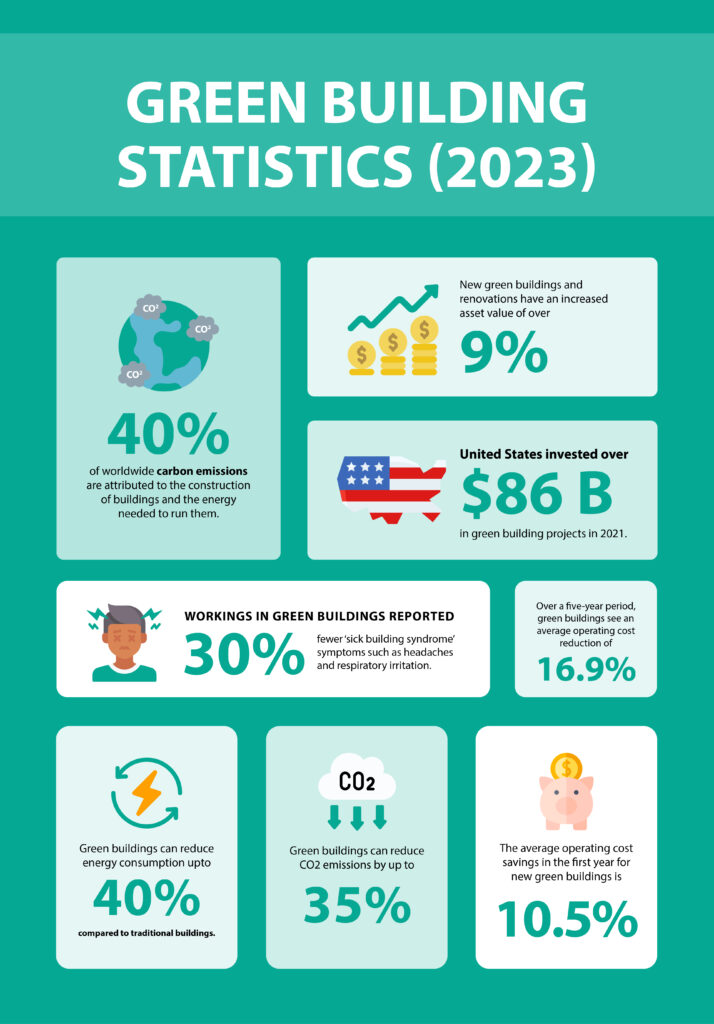
The Green Revolution: Transforming Construction with Sustainable Building Practices
In today’s rapidly changing world, environmental sustainability is a top priority. As we grapple with the challenges of climate change, the construction industry has emerged as a significant contributor to global carbon emissions. However, there is a promising solution on the horizon: green building practices. In this article, we’ll explore key statistics and insights into the world of green construction.
Key Green Building Statistics
1. Environmental Impact:
- According to the World Green Building Council, approximately 40% of global carbon emissions can be attributed to the construction of buildings and the energy required to operate them.
2. Increased Asset Values:
- Owners have reported that new green buildings and renovation projects can boost asset values by more than 9%.
3. Investment in Green Building:
- In 2021, the United States made a substantial investment of over $86 billion in green building projects.
4. Cost Comparison:
- While green construction typically costs between 1% and 12% more than non-green projects, the long-term benefits include reduced operating costs and increased asset values.
What Makes a Building Project Green?
Green building practices are guided by certifications that ensure sustainable and environmentally responsible construction and operation. The three most popular green building certifications are:
1. Leadership in Energy and Environmental Design (LEED):
- LEED is the most widely recognized green building certification globally. It focuses on various aspects, including energy efficiency, water efficiency, and indoor air quality.
2. Energy Star:
- Energy Star focuses exclusively on energy efficiency and can complement other certifications.
3. Building Research Establishment Environmental Assessment Methodology (BREEAM):
- BREEAM is the preferred methodology in the UK and certain European countries, covering a range of sustainability criteria.
Green Building Certification Criteria
Most green building certifications address similar aspects of sustainable construction. Common criteria include:
- Energy Efficiency
- Water Efficiency
- Sustainable Materials and Resources
- Indoor Environmental Quality (IEQ)
- Site Selection and Development
- Sustainable Practices
- Innovation and Design Process
- Regional Climate and Environmental Considerations
How Many Green Homes and Buildings Are There?
1. Homeowner Preferences:
- An overwhelming 84% of homeowners consider living in a green home important, with 64% willing to pay more for a green community.
2. Growth of LEED-Certified Homes:
- The number of LEED-certified homes saw nearly a 20% increase from 2017 to 2019, although they still represent a small portion of the housing market in the United States.
3. Green Office Buildings:
- In 2019, the CBRE published a Green Building Adoption Index, revealing that 13.8% of commercial office buildings in the 30 largest U.S. markets were fully green-certified.
Where Are Green Buildings Most Common?
The United States ranks second globally in green building investment, following China. Some notable achievements and statistics include:
1. Leading in LEED:
- California leads in the total number of LEED certifications, with over 7,000, followed by Texas and New York.
2. Washington D.C.’s Sustainability Pioneering:
- Washington D.C. stands out as the world’s first LEED platinum city, with a significant number of LEED certifications per million residents.
How Much Does It Cost to Build Green?
While green building typically incurs slightly higher costs than non-green projects, the added expense usually falls within a range of 1% to 12%. Key cost insights include:
- In some cases, the cost difference between green and non-green construction can be as low as 1-2%. Achieving LEED Platinum certification may require an additional investment of 7%-12%.
Benefits of Green Building
Green building practices offer numerous benefits:
1. Environmental Benefits:
- Green buildings reduce energy consumption by 30%-40%, water consumption by 20-30%, and CO2 emissions by up to 35% compared to traditional buildings.
2. Economic Benefits:
- Economically, green buildings yield lower operating costs over time, with an average operating cost reduction of 10.5% in the first year. Owners report increased asset values of over 9%.
3. Other Advantages:
- Green buildings prioritize durability, innovation in construction and design, and raise public awareness about sustainability.
Conclusion
The future of green buildings is promising, given their potential for positive environmental and economic impact. With the construction industry contributing significantly to global carbon emissions, the urgency of sustainable practices cannot be overstated.
In 2021, the United States made a remarkable investment of $86 billion in green building projects, signaling a commitment to innovation and sustainability. Green construction practices offer practical and environmentally responsible solutions, ultimately creating a more sustainable and comfortable environment for people worldwide.
The journey towards sustainability begins with every green building, bringing us closer to a greener, healthier, and more prosperous future.